How the German submarine fleet tried to crush the "mistress of the seas"
The intensification of the submarine war led to a sharp increase in Allied losses at sea. By May 1915, the 92 ship was sunk in three incomplete months: German boats were sinking one ship per day. Began to grow and the cruelty of submariners. In the first months, the captain of the U-28 Forstner "became famous," who first ordered the firing of lifeboats from the Akila steamer to the fire. Then, having decided not to bother with waiting, he sank the passenger ship “Phalaba” before the crew and passengers had left it. Killed 104 man, including women and children.
7 May an event occurred that became one of the symbols of the underwater war and seriously influenced the further course of the whole world war. The U-20 submarine, commanded by Captain Walter Schwiger, sank a huge Lusitania passenger ship off the coast of Ireland. When the ship was still in New York, the German embassy in the US through the newspapers warned of a possible attack on the airliner, but people continued to buy tickets. On May 7, the steamer was spotted by the U-20, which by that time had already used almost all the ammunition except for one torpedo, and was about to return to base. However, having found such a tasty target, Schwieger changed his mind. The largest ocean liner was torpedoed. Immediately after the first explosion, a more destructive second explosion was heard. Judicial commissions in the United Kingdom and the United States concluded that the airliner was attacked by two torpedoes. The commander of the U-20 Schwierr argued that he had fired only one torpedo at Lusitania. There are several versions explaining the origin of the second explosion, in particular, damage to steam boilers, coal dust explosion, deliberate undermining in order to substitute Germany or spontaneous detonation of ammunition illegally transported in the hold. It is very likely that the British transported ammunition on board, although they denied it.
As a result, the passenger liner sank, killing 1198 people, including nearly a hundred children. The number of dead included 128 Americans, including those belonging to the “cream of society”, which caused a storm of indignation in America. Washington was not interested in the excuses of Berlin, which indicated that the vessel was going without a flag and with a shaded name, that the passengers were warned of the danger, that the reason for the torpedoing of Lusitania was smuggling aboard her ammunition. That the German military command regarded the liner as an auxiliary cruiser. Germany was sent a sharp note, which stated that the US government could not allow the repetition of such a tragedy, the death of US citizens and protests against attacks on merchant ships. On May 21, the White House notified Germany that any subsequent attack on the ship would be regarded by the United States as a “deliberately unfriendly step.”
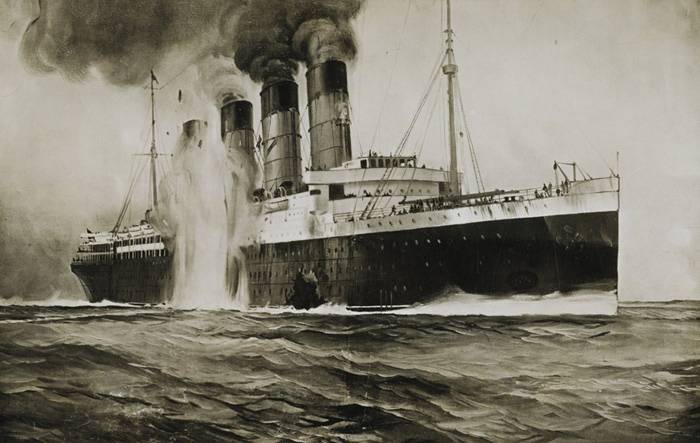
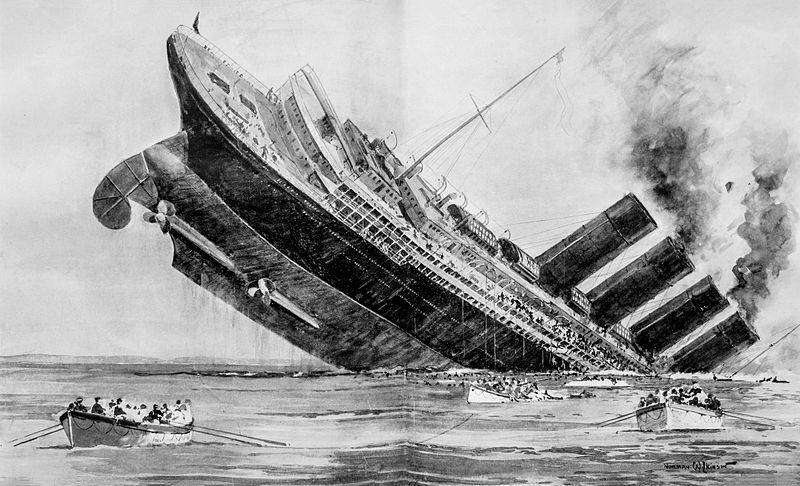
Illustration of the sinking "Lusitania" in the edition of the London News newspaper from 15 May 1915.
Relations between countries are extremely aggravated. Newspapers began to write about the imminent US entry into the war on the side of the Entente. A propaganda campaign was launched in England and the United States on the barbarism of German submariners. Former US President Theodore Roosevelt compares German actions fleet with "piracy that outperforms any murder ever committed in old pirate times." The commanders of German submarines were declared nonhumans. Churchill cynically wrote: “Despite all the horror of what happened, we must consider the death of Lusitania as an important and favorable event for the Entente countries .... Poor children who died in the ocean hit the German regime mercilessly than, perhaps, 100 thousand victims. " There is a version that the British actually planned the death of the liner in order to set up the Germans.
Such an aggravation was not at all part of the plans of the German military-political leadership. This time, Chancellor Bettman-Golweg at the meeting, which was also attended by Kaiser Wilhelm II, Ambassador Tretler as Deputy Foreign Minister, Grand Admiral Tirpitz, Admiral Bachmann, Muller, suggested curtailing the active underwater war. The Chief of the General Staff Falkenhayn also supported politicians, he believed that the German army could achieve decisive success on land. As a result, the Kaiser was convinced of the need to limit the submarine war.
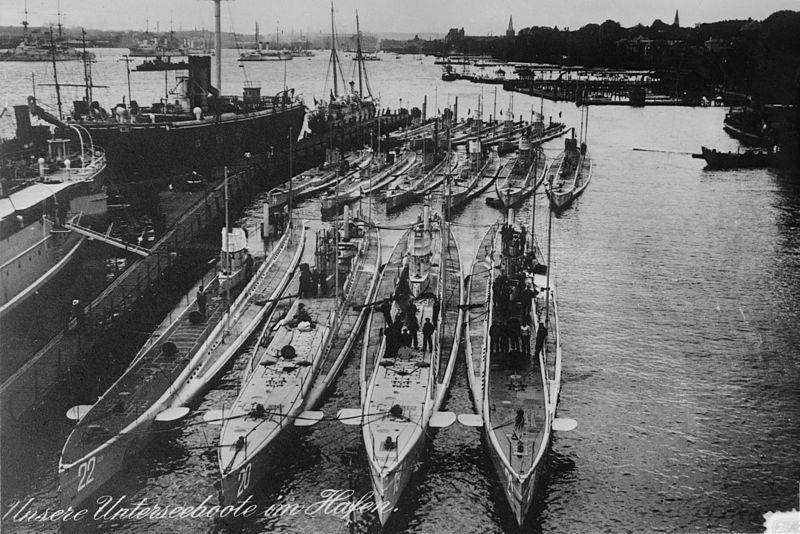
Submarine U-20 (second from left) among other boats in the harbor of Kiel
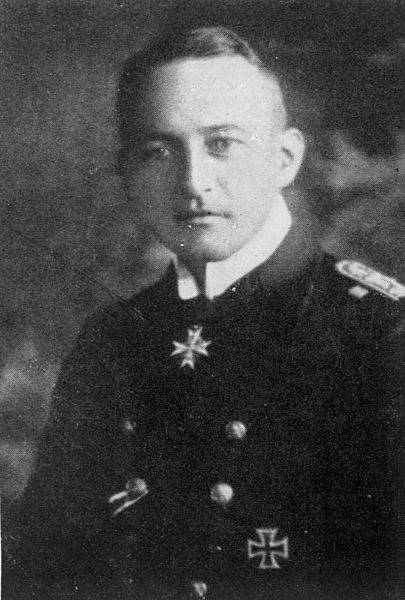
U-20 Commander Walter Schwiger
1 June 1915 of the year for the German submariners have introduced new restrictions. From now on, they were forbidden to sink large passenger ships, even if they belonged to the British, as well as any neutral ships. Tirpitz and Bachmann resigned in protest against this decision, but the Kaiser did not accept it. It is worth noting that, despite the restrictions, the German submarine fleet was still actively sinking enemy ships. In the following months, the numbers of sunk ships only increased compared with previous months. In May, 66 ships were sunk, in June already 73, in July - 97. At the same time, the Germans almost did not suffer losses in submarines. In May, not a single submarine died in the North Sea, in June - two (U-14 and U-40). The Allies still could not establish an effective anti-submarine defense.
In August, the 1915 allies already lost the 121 vessel with a total capacity of 200 thousand tons. But soon another event occurred, which finally completed the first stage of the submarine war. On August 19, the German U-24 submarine sank the Arabica passenger ship. At the same time, 44 people died. The United States reiterated its strong protest, demanded an apology and damages. The German ambassador to Washington again forcedly assured the American government that the submarine war would be limited. 26 August, the German Council decided to curtail submarine operations. August 27 submarine fleet of Germany ordered to interrupt military operations to clarify the situation. 30 August new rules for submarine warfare were introduced. The submarine fleet was ordered to leave the area of operations off the west coast of England and in the English Channel. In addition, now ships were allowed to sink only under the law of the sea. Passenger ships were forbidden to sink, cargo ships were not to sink, but to seize. Thus, the first stage of the underwater war came to an end.
The first stage of the underwater war showed great potential of the submarine fleet, especially when anti-submarine defense was ineffective. Since the beginning of the war, ships were sunk by a total displacement of 1 300 000 tons. Germany lost 22 submarines for various reasons. However, it was obvious that Germany had overestimated the capabilities of the submarine fleet. He could not lead to the naval blockade of England. Underwater warfare had little effect on the state of Britain. England had too much commercial and navy. Germany had few submarines and they were still far from perfect. Also, the underwater war, with the death of passenger ships and civilians, caused a great negative response in the world. In addition, the throwing of the government, which did not dare to start a full-scale submarine war, prevented submariners. Strongly interfered with the German admirals and the constant intervention of the military land command.
As a result, Admirals Bachmann and Tirpitz resigned. Kaiser left Tirpitz for political reasons (he was very popular among the people). Bachmann, on the post of chief of the naval headquarters, was replaced by Genning von Holtzendorf, a man close to the chancellor, who was in favor of normalizing relations with the United States. He continued the course of the folding operations of the submarine fleet. True, von Holtzendorf soon revised his views and sent several memorandums to the Kaiser and the government, in which he argued the need to resume an unlimited submarine warfare.
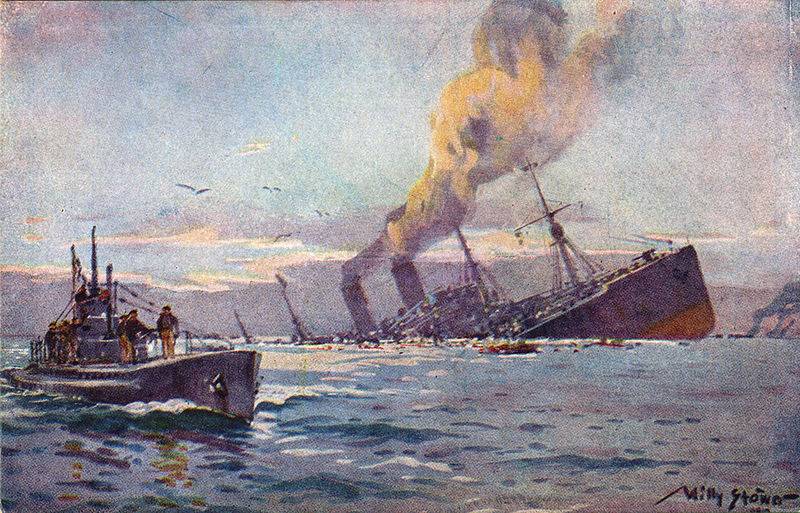
Military transport sunk by a German boat. Picture by Willy Styver
The appearance of the first submarine cruisers
The "limited" submarine war in the North Sea continued. Off the coast of Ireland and western England, the Germans focused on fighting with the help of underwater minelayers, which laid mines at ports and coasts. But small submarines carrying only 12 mines could not greatly influence the position of the enemy fleet. German submariners operated in other theaters of war: in the Mediterranean, Black and Baltic seas. True, the scale of operations there was many times inferior to the activity of military operations in the seas around England. For example, in the Black Sea there were only a few German submarines, which were mainly engaged in reconnaissance and could not create a serious threat to the Russian fleet. The underwater warfare was more active in the Mediterranean, where Austrian and German submarines attacked ships of Italy, France and Great Britain. Submarine warfare was also conducted on the Baltic Sea, although Russian and British submarines were very active here.
At the same time, the Germans continued to actively increase the power of the submarine fleet and build new submarines. They began to build real ocean submarine cruisers designed to break the blockade and deliver strategic cargo. These submarines had an increased range. They were supposed to get powerful weapons: 2 500-mm torpedo tubes with ammunition in 18 torpedoes and 2 150-mm gun, 2 88-mm gun. The firstborn were two ships class "Deutschland": "Deutschland" and "Bremen". They had a displacement of more than 1500 tons, over / underwater speed of 12 / 5 nodes, and enormous autonomy of 25 thousands of miles.
The first submarine "Deutschland", in June 1916, made a test trip to America for a load of strategic raw materials. For the most part, the boat was on the surface and only when a ship appeared, went under the water and went with the use of periscopes, and if this seemed risky, it was completely hidden in the water. Its appearance in Baltimore, where the submarine brought tons of rubber, 350 tons of nickel, 343 tons of zinc and half tons of jute on board 83, caused a great resonance in the world. The appearance of such submarine cruisers in Germany meant that now the Germans could attack enemy ships even at a considerable distance from their bases, including off the coast of America. The British tried to intercept the submarine, but on August 24 she returned safely to Germany.
In September, Germany decided to repeat the experiment. Two more boats were sent to the shores of the United States - another submarine cruiser Bremen and a submarine U-53. "Bremen" did not reach America; it died somewhere. And the U-53 safely reached Newport, fueled there and again sailed into the sea. Off the coast of Long Island, she sank seven English trading ships. Then the submarine successfully returned to the base on the island of Helgoland. In November, Deutschland made another flight to the United States with a cargo of 10 million dollars, which included precious stones, securities and medicines. She successfully returned to Germany. In February, the submarine cruiser 1917 was transferred to the German imperial fleet and was rebuilt from underwater transport into a U-155 military submarine. The ship equipped the 6 with torpedo tubes with 18 torpedoes and two 150-mm cannons. Thus, the German submariners have shown that they can now act on the enemy’s transatlantic trade lines.
Deutschland in July 1916
The beginning of the second stage of a large-scale underwater war
By the end of 1916, the martial law of the Central Powers began to deteriorate rapidly. During the 1916 campaign of the year, Germany could not achieve decisive success either in the West or in the East. Reduced human resources, there was a shortage of raw materials and food. It became obvious that in the war of attrition the German bloc was waiting for defeat. In Germany, they came to the conclusion that a “merciless” submarine war should be renewed.
As noted by the military historian A. M. Zayonchkovsky: “Basically, the calculation of the Germans was very simple: the British had a tonnage of approximately 1917 million tons by the 16; Of these, 7 million tons were needed for military needs, the remaining 9 million tons were needed for the life of the country during the year. If we manage to destroy a large percentage of the total tonnage, and neutral vessels, fearing to be sunk, will cease their voyages to England, then the continuation of the war will be impossible for the latter. ”
22 December 1916 of the year von Holtzendorf addressed the Chief of General Staff Field Marshal Hindenburg with an extensive memorandum. In the document, the admiral once again emphasized the need to start an unrestricted submarine war. It was believed that if England was withdrawn from the war, it would have a devastating effect on the entire Entente, which depended on the capabilities of the British fleet. It is clear that the risk of entering the US war was taken into account. However, supporters of an unlimited underwater war believed that even if Washington sided with the Entente, there was no particular threat. The United States does not have a large land army that would strengthen its allies in the French theater and America already materially supports the Entente countries. Also, the Germans hoped to bring England to its knees before the United States managed to form and transfer considerable forces to Europe.
As a result, the German government 27 January 1917 of the year decided to resume unrestricted submarine warfare at sea. January 31 Berlin has notified the world about the beginning of an unrestricted submarine war.
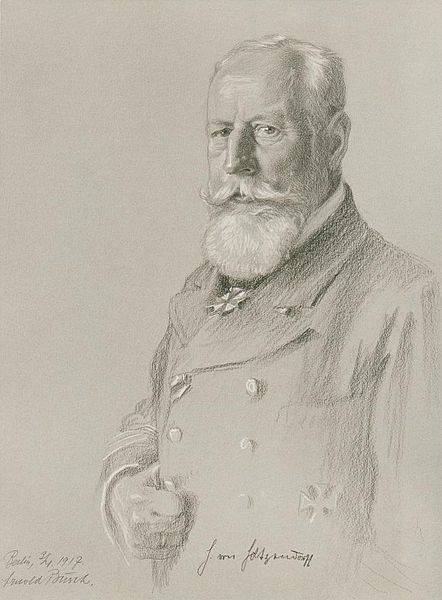
Henning von Holtzendorf
Underwater warfare at the end of 1916 - the beginning of 1917.
December 9 1916 England reported the flooding of three civilian steamboats in the English Channel. On December 11, in the English Channel, a German submarine sunk the steamer Rakiura, flying the flag of neutral Norway. The crew managed to escape. On the same day, off the coast of Sicily, the German submarine UB-47 sunk the British transport Magellan. 20 December: A German U-38 submarine sank the British ship Eatonus in 72 miles northeast of Malta. 27 December 1916, the German UB-47 submarine under the command of Lieutenant-Commander Steinbauer off the coast of Sicily, the French battleship Golua was scuttled. The crew managed to evacuate, killing 4 man.
With the beginning of 1917, the Germans dramatically stepped up their submarine fleet. 1 January 1917 of the same submarine was torpedoed nearby and sank the British airliner Ivernia, which was transporting troops to Egypt. Thanks to the skillful actions of the crew, most of the soldiers were able to escape in boats, 36 people were killed. Only in one day 2 of January they sunk (mainly in the Bay of Biscay and off the coast of Portugal) 12 ships - 11 of commercial ships that belonged to Norway, England, France, Greece and Spain, and the Russian battleship Peresvet.
The Peresvet was the lead ship of a series of three somewhat different battleships (the series included Oslyabya and Pobeda), built at the turn of the 19th — 20th centuries in the Baltic. 1902, the ship arrived at Port Arthur. During the Russian-Japanese war, this ship was sunk in the harbor of Port Arthur, then raised by the Japanese, repaired and put into operation under the name "Sagami". In connection with the need for ships for the flotilla of the Arctic Ocean being created, and also for possible participation, at least symbolically, in the operations of the Allies in the Mediterranean, Russia in 1916 asked Japan to sell it to former Russian ships inherited as war trophies . The Japanese agreed to concede only three old ships: the battleships "Tango" (the former "Poltava") and the "Sagas" and the cruiser "Soy" (the former "Varyag").
The buyout of Sagami cost Russia 7 million yen. 21 March 1916, all three ships arrived in Vladivostok. In October 1916, after repair, Peresvet went to Europe through the Suez Canal. It was supposed that the overhaul of the ship in England would be carried out first, and then he would join the Russian Northern Flotilla. But 2 in January 1917 in 10 miles from Port Said in 17.30 "Relight" was blown up by the bow and stern on two mines at once. The ship quickly sank, and the commander ordered the crew to flee. Only one steamboat managed to lower it. In 17.47, Peresvet tipped over and sank. The nearby English destroyer and French trawlers lifted 557 people out of the water, several of whom later died from wounds and hypothermia. Killed 252 team member Peresvet. Later it turned out that the ship was killed on a minefield, exposed by the German submarine U-73.
Memorial plate with the names of sailors from Peresvet installed on the grave in the cemetery in Port Said
Over the next few days, German submarines in the Mediterranean and in the Bay of Biscay sunk 54 of the ship of the Entente countries and neutral countries - mainly cargo steamers and trawlers. From 9 to 15 in January in the Bay of Biscay, the English Channel, the North, Mediterranean and Baltic Sea, German submarines sank 29 ships (most were British, but also French, Norwegian, Danish, Swedish). German submariners suffered only one loss - on January 14, the UB-37 submarine was submerged in the English Channel.
On January 17, in the Atlantic Ocean, near the Portuguese island of Madeira, the German auxiliary cruiser “Mowe” sank the English merchant ship. From 16 to 22 in January, the German submarine sunk in the Atlantic Ocean (mainly off the coast of Portugal and in the Bay of Biscay) and in the Mediterranean Sea a total of 48 of the commercial ships of the Entente countries and neutral countries.
Between 23 and 29 in January, German U-boats sank a total of 48 ships, including 1 Swedish, 3 Spanish, 10 Norwegian, 1 Danish and 1 Dutch, despite the neutrality of these countries. January 25 in the Irish Sea on a mine, set by a German submarine, hit the British auxiliary cruiser "Laurentik". The cruiser followed from Liverpool to Halifax (Canada) and already at the exit from the Northern Strait came across a German mine. Killed 378 of the 745 people on board. This tragedy could be regarded as usual compared to other losses of the British royal fleet, and other fleets during the First World War. In addition, the Laurentik itself was not even a warship and was not a valuable unit of the British fleet. It was a passenger liner, hastily converted before the war into an auxiliary cruiser. The only advantage of it was only a fairly high speed.
However, the death of this ship deserved the closest attention of the British government. The place where the cruiser died was immediately taken under the protection of British ships. The fleet command was eagerly awaiting the arrival of the divers. The reason was that more than 3200 gold bars, packed in boxes weighing 64 kilograms each, with a total weight of almost 43 tons from UK gold reserves, went to the bottom. The cruiser broke all the records that existed before it, yet not a single ship carried so much gold. Gold was intended for the US government as payment for supplies of food and military equipment for the UK. It is worth noting that during the war, Washington was greatly enriched in supplying Entente countries and neutral powers, and also turned from a debtor into a global creditor, as the warring powers were forced to pay in gold for American supplies, and also took loans from the United States. The loss of this ship hit hard on British finances.
Soon to the place of death of the ship arrived divers. The first descent under water allowed to detect the sunken cruiser and outline a plan for further work. The ship lay on the port side, its upper deck was only 18 meters from the sea surface. A special vessel arrived with special equipment for underwater work. Since the Admiralty did not require to save the ship itself, but only to get its contents, it was decided to use explosives. The beginning of the work was successful, several boxes were raised. But then a storm broke out that lasted a whole week. When the rescuers returned to the "Laurentik", they were waited by a sad sight. Under the blows of storm waves, the hull of the vessel was folded into an accordion, the passage through which the divers pulled out their first finds turned into a crack. The vessel also shifted and sank to a depth of 30 meters. When the divers re-cleared their way to the treasure, they were surprised to find that all the gold had disappeared. It turned out that under the action of the storm the cruiser sheathing dispersed, all the gold fell down and was somewhere there, under tons of steel fragments. As a result, the work was strongly delayed. Divers with the help of explosives made their way, looking for gold. In the fall of 1917, work was temporarily interrupted due to the onset of a storm period. Since America entered the war on the side of the Entente, the work was postponed for the postwar period. Only in 1919, the rescue ship again approached the place of death of the cruiser. And again the divers had to start all over again. Now they had to clean the stones and sand, which were compressed into a dense mass and resembled cement. It was impossible to use explosives, gold would finally fall asleep. Divers using crowbars and hoses, through which water was supplied under high pressure, broke off pieces of "cement" and sent them to the surface. As a result, work continued until the 1924 year. During the search, a huge ocean liner was literally cut into pieces and dragged along the bottom of the ocean. During the entire search period, divers made more than 5000 dives and returned almost all the gold to the British treasury.
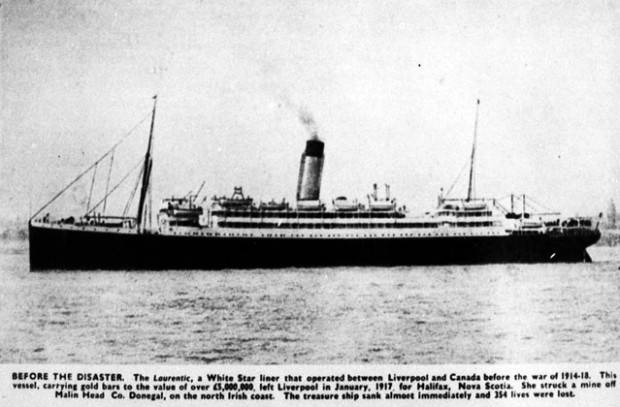
British auxiliary cruiser "Laurentik"
In the first five days of the unrestricted submarine warfare, which was officially declared 31 on January 1917, the 60 ships of the Entente countries and neutral powers, including one American, were sunk by submarines in the Atlantic Ocean and in the Mediterranean Sea. Between 6 and 12 in February, German submarines flooded 77 vessels, including 13 ships from neutral countries. During the period from 13 to 19 in February, the Germans sank even more merchant ships of the Entente countries and neutral states - 96. Between 20 and 26 February, the Germans sunk the 71 ship. From February 27 to March 5, German submarines flooded 77 ships.
In just the first three months of 1917, German submariners sank 728 ships with a total displacement of 1 168 000 tons. As a result, on average, the Germans drowned 8 ships per day during these months. True, their losses have also increased - in three months 9 submarines. However, the pace of construction of new submarines also increased, and for the same period in Germany built 24 submarine ship. The main problem now was the lack of trained personnel.
To be continued ...
- Alexander Samsonov
- 1917 Campaign
The transition of the Central Powers to a strategic defense
Entente plans for 1917 year: bet on a decisive victory in the war
Russian army to the beginning of the 1917 campaign of the year: the approach of the general collapse
Attack without shot: Mitav operation
How Germany began the unlimited submarine war
German submarine vs UK
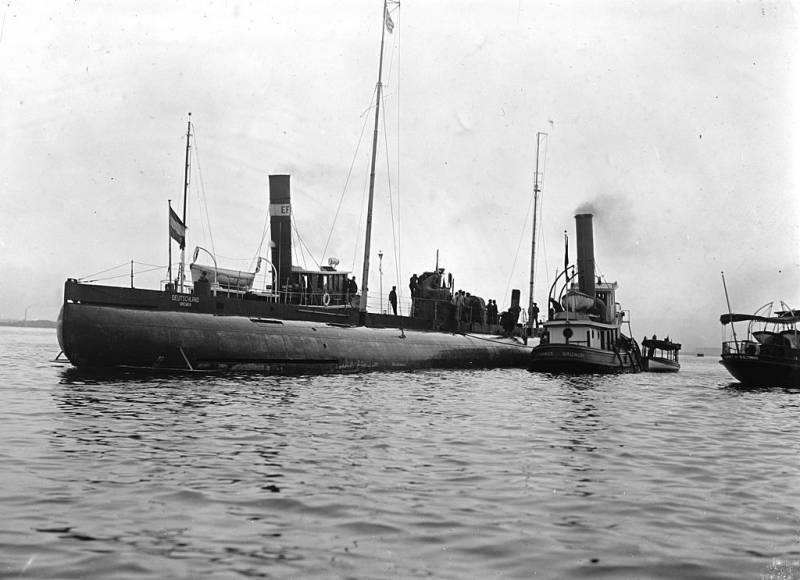
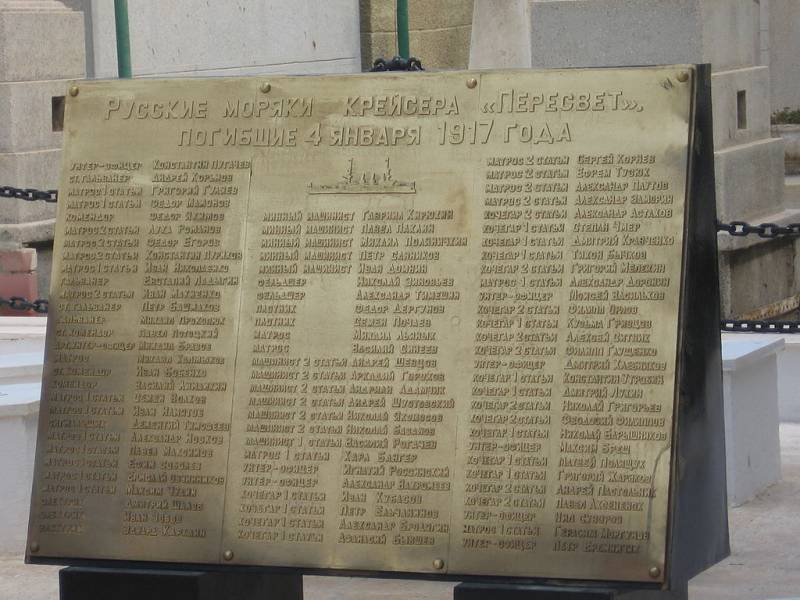
Information